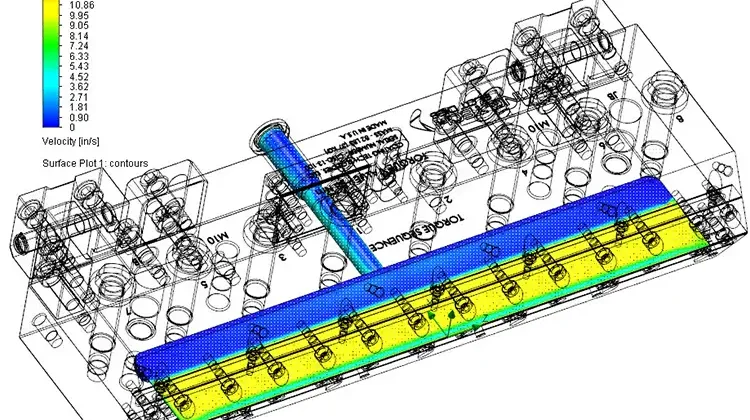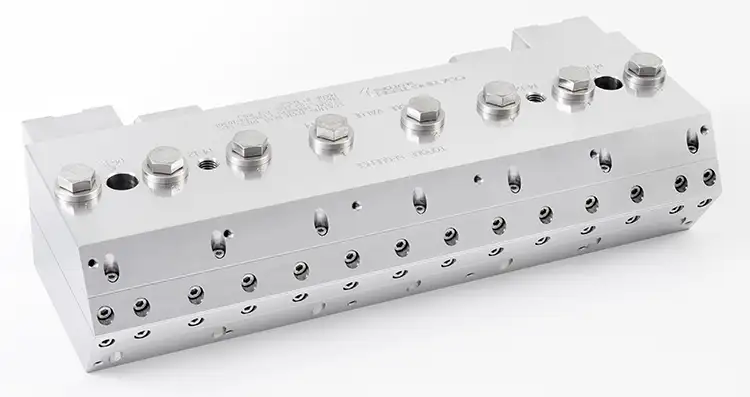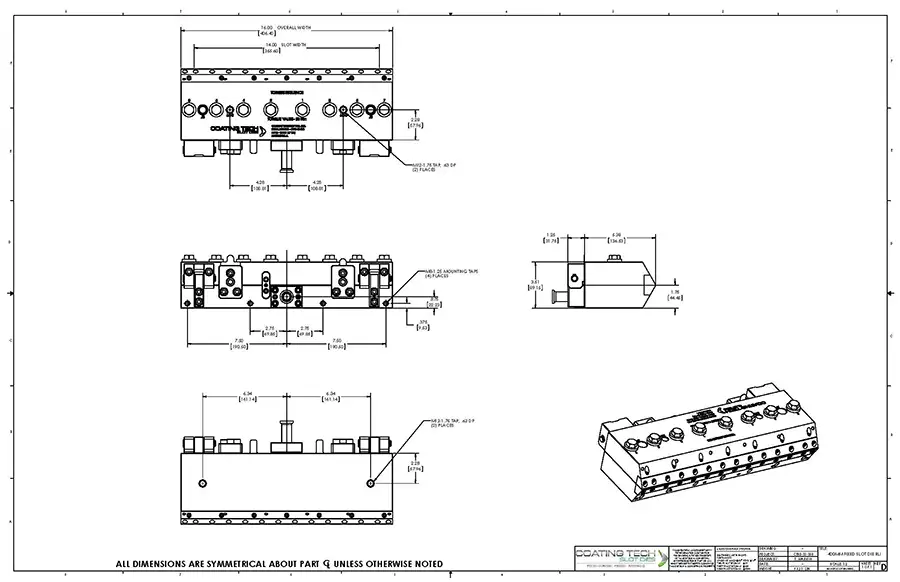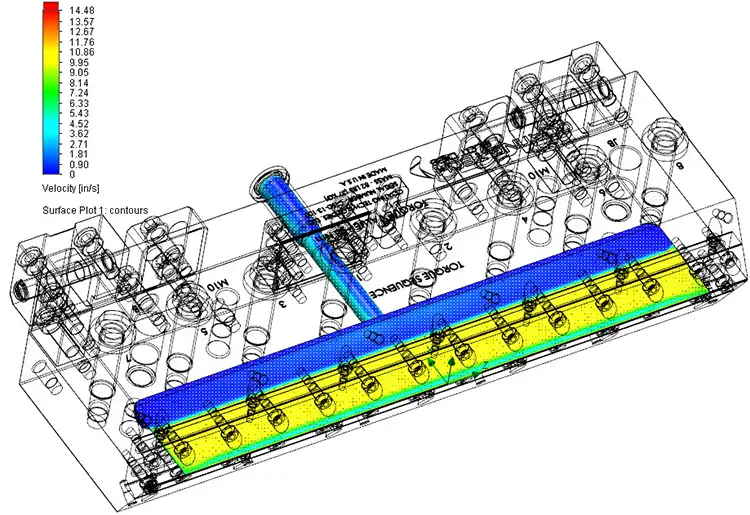
By Mark Miller, CEO, Coating Tech Slot Dies LLC
Introduction
As the world of solution web coating has advanced, so has the design and manufacturing of the equipment. In the world of pre-metered coating, slot-die technology has progressed rapidly since its early years because of computer simulation. The ability to take the rheological-fluid characteristics and the process setpoints to properly design the internal manifold of the slot die now is not only possible but sometimes necessary.

In pre-metered coating, a slot die is the control valve that turns fluid flow through a pipe into a precise, flat and even coating on a continuously moving substrate (see Figure 1). How does a chunk of metal do this? I like to think of a slot die as a series of compression and relaxation zones – or gaps. These gaps need to shape the fluid into the form required for final distribution at the precise pressure and consistent velocity as it is deposited onto the substrate. You could pour the fluid on with a hose, paint it on with a brush or spray it on as a mist, but if precision is your concern, then slot dies are your method.
Traits of manifold-cavity design
The manifold cavity is a chamber that the fluid is introduced to from the pump. This manifold has a shape dictated by the molecular character of the fluid itself. This character is a function of the rheology (dynamic viscosity) and the viscoelasticity. These two characteristics define the shape of the manifold with two main variations:
- A Newtonian fluid dictates an infinite (same cross-section from center to end) cavity design.
- A polymeric fluid dictates a “coat-hanger” (curved) cavity design.
To feed the manifold cavity properly, you have to consider the pressure drop across the path traveled from the pump through the slot die and out the slot end of the die, all while maintaining proper velocity throughout the system. Pressure drop along the cavity is the driving force for flow across the width of the slot die as fluid is introduced to the slot die from a central entrance. If the pressure gradient within the manifold is not even, the flow also will be uneven and present as an uneven coatweight across the substrate.
With polymeric fluid, flow control at the exit of the slot die may be required to “shape” the flow. This usually is presented in the form of lip adjusting bolts, with the lip of the slot die being the metal tips of the upper and lower body of the slot to be formed.
Some slot dies are designed with a secondary manifold prior to the slot exit to allow for a smaller relaxation zone. This secondary manifold provides for corrections in flow when a smaller primary manifold is required for initial flow distribution but fails to optimize flow speed prior to slot-die coating.
After distribution within the manifold cavity chamber (a relaxation zone), the fluid is compressed through a slot (a compression zone) that has a height dictated by the viscosity of the fluid. The higher the viscosity, the larger the opening; the lower the viscosity, the smaller the opening. The idea is to have the fluid move at the same velocity as it exits the slot die, therefore the fluid forces control the distribution onto the substrate.
Another way to view the coating phenomenon of slot-die technology is to consider that the precision is dependent on uniform volumetric movement per unit width across the width of the substrate. But, be careful! The slot opening is a very powerful parameter: It affects coating speed to the power of three. For every unit of slot-height change, the speed is affected in triplicate.

In the end, a pre-metered slot-die coating system (see Figure 2) should be optimally designed based off the liquid properties and operating conditions. Too much fluid or process-condition change, and the slot die will be ineffective. Design the coating method based off known limits of production, and you will be successful.
Operational concerns
There are four areas that are of interest to the fluid-coating operator:
- Analysis of process conditions for stable flow,
- Internal flow conditions that cause defects,
- Coating-window determination and when defects occur and
- Start and stop phenomenon.
A computer model does better with boundary conditions, so the study of internal flow within a coating head is easier than coating behavior outside the coating head. In the study of flow within an enclosed coating head, the fluid can be studied as a smaller section and expanded across the full coating width. This small section analysis is called Computation Flow Dynamics or Finite Element Analysis (FEA). By taking a finite, defined section of fluid flow within a slot die, one can understand the flow as it is affected by volumetric changes, shear of mechanical spaces, pressure differences and velocity gradients. FEA takes the sections determined by the computer and a mesh of these sections is formed, and thus the effects of the flow are determined. This can take a high-powered computer hours to complete for accurate understanding.
Within the multi-factorial analysis, the simulation can tell a trained designer where the shape and design of the coating head’s internal flow geometry needs to be adjusted so as to control flow as it exists in the slot die. Geometry such as fluid-inlet sweeps, manifold-end sweeps and transitional radii are not accounted for easily unless 3D flow modeling is employed.

Within the slot-die manifold, a particle study can provide an understanding of residence time, agglomeration of suspended particles and potential dead zones for fluid flow. For some fluids, the dead-zone areas can lead to particle buildup or excessive temperature issues. The manifold study with a computational method takes the basics of finite element analysis and applies them to a strong understanding of flow control (see Figure 3).
In a perfectly uniform coating flow, 2D steady flow would be all that is required to develop a model. However, if a coating defect is created at a set process condition, the use of 3D computational studies allows for an understanding of the fluid effects of mechanical dimensional changes. The final point of the slot-die exit is the slot gap, where the fluid should be moving at constant velocity, pressure, volumetric flow rate and viscosity.
Post-slot-die fluid analysis
After the fluid exists the slot die, more empirical equations need to be applied because of the lack of boundary conditions and the effect of the production environment. Determining the coating window includes the simulated, optimum-coating condition at the slot-die exit in addition to the effects of the moving substrate and the air barrier between the fluid and substrate. Considering the flow outside the slot die as you do within the slot die does not work as well as one would expect, but it is a good starting point.
The most complicated coating issues typically are associated with the start-and-stop of coating onto a substrate. Whether the start-and-stop is associated with a splice of the substrate or a planned, intermittent-coating pattern, the need to reduce scrap and control flow still is there. While no single computational algorithm has been presented to understand all the coating effects with various fluids on substrates in all environmental conditions, the control of the flow of fluid out of the slot die is the best starting point. Maintaining consistent viscosity, velocity, pressure and volumetric flow rate across the full coating width of the slot die will lead to better start- and stop-control.
Conclusion
Prior to the use of computer modeling of fluid flow, experimentation was the only option. Slow and expensive, empirical modeling based off past experience did not allow for exacting design and manufacturing. In addition to being costly, the experimental variation makes multi-factorial understanding difficult. The precision developed through computer simulations allows for coating nanowire-suspended fluids and optically clear coatings without the guess work. As coating production goes faster and thinner with more complex fluids, computer simulation and design are sometimes the only options.
Mark Miller, CEO of Coating Tech Slot Dies LLC (Eau Claire, WI), holds a Bachelor’s degree in Chemical Engineering from the University of Wisconsin-Madison, a Master’s degree in Polymer Science and Technology from Lehigh University and a J.D. from Hamline Mitchell School of Law. He has worked at 3M Co., and Coating Tech Slot Dies, and is a frequent presenter at AIMCAL R2R Conferences. Miller can be reached at 715-544-7568, mobile: 715-456-9545, mark.miller@slotdies.com, www.slotdies.com.

